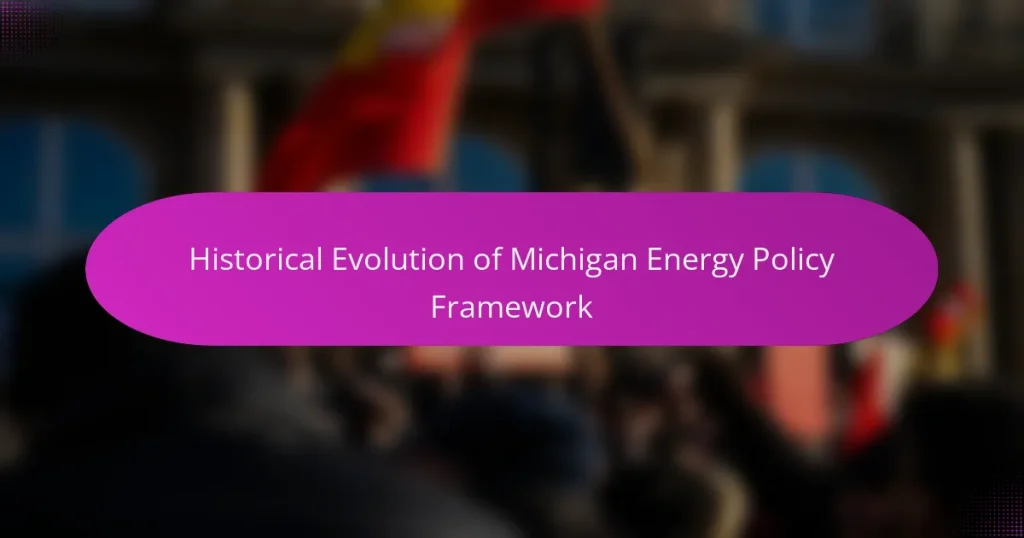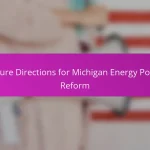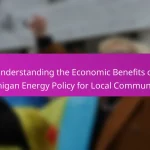
What is the Historical Evolution of Michigan Energy Policy Framework?
The historical evolution of Michigan’s energy policy framework has undergone significant changes since the early 20th century. Initially, energy policy focused on the development of coal and natural gas resources. In the 1970s, the energy crisis prompted a shift towards conservation and renewable energy sources. The establishment of the Michigan Public Service Commission in 1939 marked a key regulatory milestone. In the 1990s, deregulation efforts aimed to increase competition in the energy market. The 2008 Energy Optimization Act further promoted energy efficiency measures. More recently, Michigan has committed to reducing greenhouse gas emissions and increasing renewable energy usage. In 2016, the state set a goal of achieving 15% renewable energy by 2021. The evolution reflects a growing emphasis on sustainability and environmental responsibility in energy policy.
How has the energy policy framework in Michigan developed over time?
The energy policy framework in Michigan has evolved significantly over time. Initially, Michigan’s energy policies were largely focused on the development of fossil fuels and traditional energy sources. In the late 20th century, concerns about environmental impacts and energy security began to reshape these policies. The 2008 Energy Optimization Act marked a pivotal shift towards energy efficiency and renewable energy sources. This act aimed to reduce energy consumption and promote sustainable practices.
Subsequently, the 2016 Clean Power Plan set ambitious targets for reducing carbon emissions. Michigan’s policies began to increasingly incorporate renewable energy standards, aiming for 15% of energy from renewable sources by 2021. The state has also invested in programs to support solar and wind energy development.
Recent legislative efforts have continued to emphasize clean energy and grid modernization. The establishment of the Michigan Energy Innovation Business Council highlights the growing importance of clean technology. Overall, Michigan’s energy policy framework has transitioned from fossil fuel reliance to a more diversified approach that prioritizes sustainability and innovation.
What key historical events influenced Michigan’s energy policies?
Key historical events that influenced Michigan’s energy policies include the 1973 oil crisis and the 1990 Clean Air Act amendments. The 1973 oil crisis led to a push for energy independence and diversification. As a result, Michigan began investing in alternative energy sources. The 1990 Clean Air Act amendments prompted stricter emissions regulations. This legislation pushed Michigan to adopt cleaner energy technologies. Additionally, the 2008 Great Recession influenced energy policy by highlighting the need for economic stability through energy efficiency. These events collectively shaped a more sustainable energy framework in Michigan.
How have changes in technology impacted energy policy in Michigan?
Changes in technology have significantly impacted energy policy in Michigan. The rise of renewable energy technologies, particularly solar and wind, has prompted state policies to support clean energy generation. For instance, Michigan’s Renewable Portfolio Standard mandates that 15% of energy must come from renewable sources by 2021. Additionally, advancements in energy efficiency technologies have led to policies promoting energy-saving measures in homes and businesses. The implementation of smart grid technologies has also influenced energy management policies, enhancing reliability and reducing costs. These technological advancements have driven Michigan to adapt its energy policies to promote sustainability and reduce greenhouse gas emissions.
What are the foundational principles of Michigan’s energy policy?
The foundational principles of Michigan’s energy policy focus on sustainability, reliability, and affordability. Sustainability aims to promote renewable energy sources and reduce greenhouse gas emissions. Reliability ensures the energy supply is consistent and meets consumer demand. Affordability seeks to keep energy costs manageable for residents and businesses. These principles guide the development and implementation of energy programs in Michigan. They align with state laws and initiatives aimed at enhancing the energy landscape. The Michigan Energy Policy also emphasizes energy efficiency and innovation. This approach supports economic growth and job creation in the energy sector.
What role does sustainability play in Michigan’s energy policy framework?
Sustainability is a core principle in Michigan’s energy policy framework. It drives the state’s commitment to reducing greenhouse gas emissions. The framework aims to transition to renewable energy sources such as wind and solar. Michigan’s Clean and Renewable Energy Plan emphasizes energy efficiency and conservation. The state has set specific targets for renewable energy generation. For instance, Michigan aims for 50% of its energy to come from renewable sources by 2030. This focus on sustainability supports economic growth while protecting the environment. The Michigan Public Service Commission oversees the implementation of these policies.
How does Michigan’s energy policy address economic considerations?
Michigan’s energy policy addresses economic considerations by promoting renewable energy development and energy efficiency. The policy aims to create jobs in the clean energy sector. According to the Michigan Public Service Commission, the state has seen significant investment in wind and solar energy. This investment has generated over 20,000 jobs since 2008. Additionally, the policy encourages utility companies to invest in energy-saving programs. These programs help reduce costs for consumers and businesses. The focus on economic growth aligns with the state’s goal of reducing greenhouse gas emissions. Overall, Michigan’s energy policy seeks to balance economic growth with environmental sustainability.
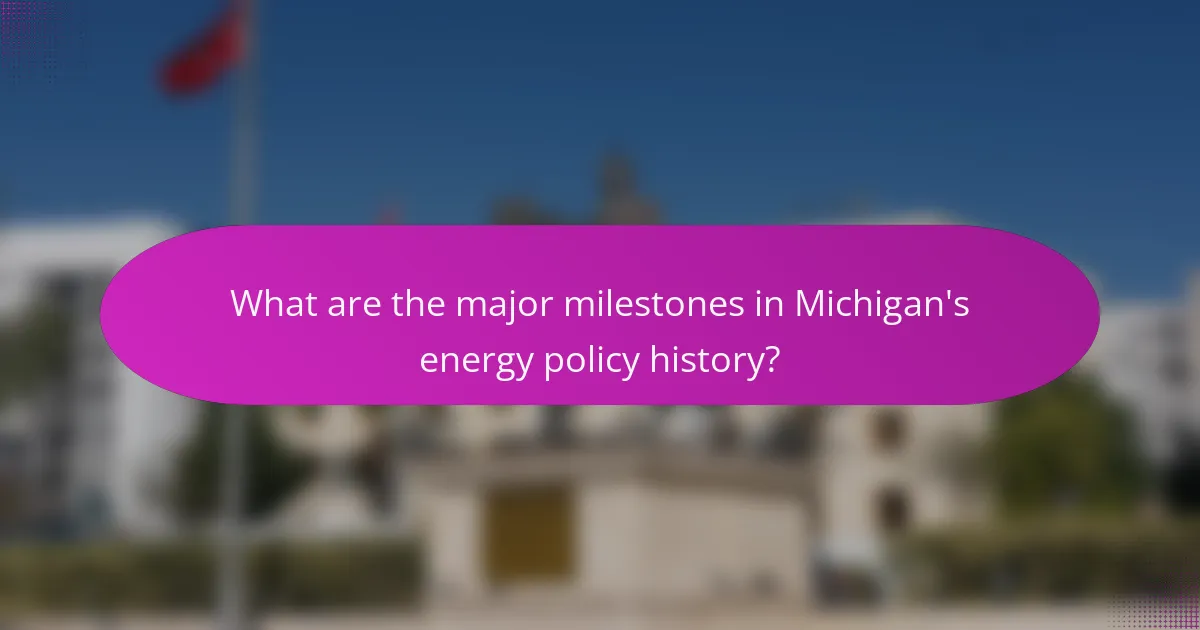
What are the major milestones in Michigan’s energy policy history?
Michigan’s energy policy history includes several major milestones. In 1976, the state established the Michigan Public Service Commission to regulate utility rates. The 1995 Electric Customer Choice Act allowed for competition in the electricity market. In 2008, the state implemented the Clean, Renewable, and Efficient Energy Act, promoting renewable energy sources. The 2016 energy law set a goal of 15% energy waste reduction by 2021. In 2019, Michigan adopted a new energy plan emphasizing clean energy and reducing carbon emissions. Each of these milestones reflects a significant shift in Michigan’s approach to energy management and sustainability.
What significant legislation has shaped Michigan’s energy landscape?
The significant legislation that has shaped Michigan’s energy landscape includes the Clean, Renewable, and Efficient Energy Act of 2008. This act established a renewable energy standard requiring utilities to obtain 10% of their energy from renewable sources by 2015. It also promoted energy efficiency measures to reduce overall energy consumption. Another key piece of legislation is the Energy Optimization Act of 2008, which mandated energy efficiency programs for electric and gas utilities. Additionally, the 2016 Michigan Energy Law aimed to increase renewable energy targets to 15% by 2021. These laws collectively transformed Michigan’s energy policy towards sustainability and efficiency.
How did the Public Act 295 of 2008 affect energy policy in Michigan?
Public Act 295 of 2008 significantly transformed energy policy in Michigan. It established a renewable energy standard requiring utilities to obtain at least 10% of their energy from renewable sources by 2015. The act also promoted energy efficiency programs, mandating utilities to implement energy-saving initiatives. This legislation aimed to reduce reliance on fossil fuels and lower greenhouse gas emissions. Furthermore, it created a framework for the development of alternative energy sources, including wind and solar power. The act’s implementation led to increased investment in renewable energy infrastructure across the state. Overall, Public Act 295 marked a pivotal shift towards sustainable energy practices in Michigan.
What impact did the Clean Power Plan have on Michigan’s energy framework?
The Clean Power Plan significantly influenced Michigan’s energy framework by promoting a shift towards cleaner energy sources. It aimed to reduce carbon emissions from power plants, aligning with state goals for energy efficiency and renewable energy. The plan encouraged Michigan to invest in renewable energy technologies, such as wind and solar. As a result, Michigan saw an increase in renewable energy generation, contributing to its energy diversification. The state’s utilities began to retire coal-fired plants in favor of cleaner alternatives. This transition supported Michigan’s commitment to reducing greenhouse gas emissions by 28% by 2030 from 2005 levels. The Clean Power Plan also fostered regulatory changes, enhancing state-level energy policies focused on sustainability and environmental protection.
What role do stakeholders play in shaping Michigan’s energy policy?
Stakeholders play a crucial role in shaping Michigan’s energy policy. They include government agencies, utility companies, environmental groups, and consumers. Each stakeholder contributes unique perspectives and interests. Government agencies set regulatory frameworks and enforce policies. Utility companies provide insights into operational feasibility and infrastructure needs. Environmental groups advocate for sustainable practices and renewable energy sources. Consumers express demand and preferences for energy services. Their collective input influences policy decisions, ensuring a balanced approach. For example, the Michigan Public Service Commission engages stakeholders in public hearings to gather feedback on energy plans. This collaborative process helps align energy policy with the needs and values of the community.
How do governmental agencies influence energy policy decisions?
Governmental agencies influence energy policy decisions through regulation, funding, and research initiatives. They create and enforce laws that shape energy production and consumption. For example, the U.S. Environmental Protection Agency (EPA) sets standards for emissions that impact energy sources. State agencies, like the Michigan Public Service Commission, regulate utilities and oversee energy rates. These agencies also allocate funding for renewable energy projects, driving innovation. Additionally, they conduct research to inform policy, such as studies on energy efficiency. Their influence is evident in the transition to cleaner energy sources mandated by legislation.
What is the impact of public opinion on Michigan’s energy policies?
Public opinion significantly influences Michigan’s energy policies. Policymakers often consider public sentiment when drafting legislation. In recent years, there has been a growing demand for renewable energy sources. Surveys indicate that a majority of Michigan residents support clean energy initiatives. This public backing has led to increased investment in wind and solar energy projects. Additionally, public opinion has prompted lawmakers to prioritize energy efficiency programs. Local advocacy groups also play a crucial role in shaping energy discussions. Their efforts often reflect the values and concerns of the community. Overall, public opinion serves as a driving force in the evolution of Michigan’s energy policies.
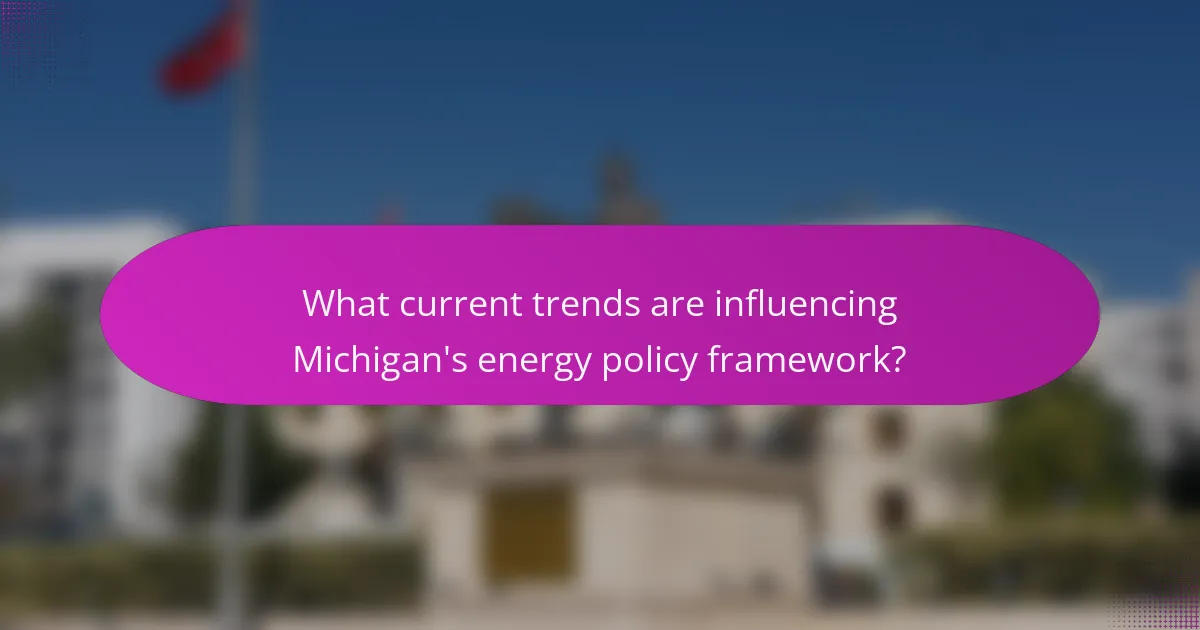
What current trends are influencing Michigan’s energy policy framework?
Current trends influencing Michigan’s energy policy framework include a shift towards renewable energy sources, energy efficiency initiatives, and regulatory changes. The state aims to achieve 50% renewable energy by 2030. This goal aligns with the broader national trend of decarbonizing the energy sector. Additionally, energy efficiency programs are being expanded to reduce overall consumption. The Michigan Public Service Commission is implementing new regulations to support these initiatives. These trends are driven by public demand for cleaner energy and the need to address climate change. Recent surveys show that a significant majority of Michiganders support renewable energy development.
How is renewable energy being integrated into Michigan’s energy policy?
Renewable energy is being integrated into Michigan’s energy policy through legislative mandates and initiatives. The state has set a goal to achieve 15% renewable energy by 2021, as established by the 2008 Public Act 295. This act requires utilities to meet specific renewable energy standards. Additionally, the Clean and Renewable Energy and Energy Efficiency Act promotes investment in solar, wind, and biomass energy. Michigan’s 2019 energy policy update further emphasizes the transition to clean energy sources. The state also offers incentives for renewable energy projects, including tax credits and grants. These actions reflect Michigan’s commitment to reducing greenhouse gas emissions and increasing energy independence.
What are the challenges and opportunities for solar energy in Michigan?
Solar energy in Michigan faces challenges and presents opportunities. Key challenges include fluctuating state policies and limited grid capacity. These factors can hinder solar adoption and investment. Additionally, cold winters reduce solar efficiency, impacting energy production. However, opportunities exist in increasing public awareness and demand for renewable energy. The state has abundant solar potential, with over 200 sunny days annually. Financial incentives, such as tax credits, encourage solar installations. Michigan’s commitment to reducing carbon emissions supports solar energy growth. The state’s diverse economy can benefit from job creation in the solar sector.
How is wind energy being supported by current policies in Michigan?
Current policies in Michigan support wind energy through various incentives and regulatory frameworks. The state’s Renewable Portfolio Standard (RPS) mandates that utilities obtain a certain percentage of their energy from renewable sources, including wind. As of 2023, Michigan requires 15% of energy to come from renewables, with plans to increase this target. Additionally, the state offers tax incentives for wind energy projects, which encourage investment. The Michigan Public Service Commission (MPSC) oversees the implementation of these policies. These initiatives aim to reduce greenhouse gas emissions and promote energy independence. The state has seen significant growth in wind energy capacity, with over 3,000 megawatts installed as of 2022. This growth is supported by state-level programs that streamline the permitting process for new wind projects.
What strategies are being implemented to improve energy efficiency in Michigan?
Michigan is implementing various strategies to improve energy efficiency. These strategies include the promotion of energy efficiency programs through utility companies. The state encourages residential and commercial energy audits to identify areas for improvement. Financial incentives are offered for energy-efficient upgrades and retrofits. Michigan also supports the adoption of renewable energy sources, which indirectly enhances overall efficiency. The state has established energy efficiency standards for appliances and buildings. Additionally, public awareness campaigns educate residents about energy-saving practices. The Michigan Public Service Commission oversees and regulates these initiatives to ensure compliance and effectiveness.
What programs exist to promote energy conservation among consumers?
Programs that promote energy conservation among consumers include the Energy Efficiency Program and the Michigan Saves program. The Energy Efficiency Program offers incentives for residential and commercial energy-saving upgrades. This program aims to reduce energy consumption and lower utility bills. Michigan Saves provides financing options for energy efficiency improvements. It helps consumers invest in energy-saving technologies without upfront costs. Additionally, the Home Energy Report program educates consumers on their energy use. It provides personalized recommendations for reducing consumption. These programs collectively contribute to Michigan’s goal of enhancing energy efficiency and sustainability.
How do utility companies contribute to energy efficiency initiatives?
Utility companies contribute to energy efficiency initiatives by implementing programs that promote energy-saving practices. They offer rebates and incentives for energy-efficient appliances and upgrades. These companies also conduct energy audits to identify areas for improvement in homes and businesses. Additionally, they provide educational resources to inform customers about energy conservation techniques. In Michigan, utility companies are required to meet energy savings targets set by the state. For example, the Michigan Public Service Commission mandates specific energy efficiency programs. These efforts collectively help reduce overall energy consumption and lower utility bills for consumers.
What are the future prospects for Michigan’s energy policy framework?
The future prospects for Michigan’s energy policy framework include a strong emphasis on renewable energy and sustainability. Michigan aims to achieve a 50% renewable energy target by 2030. This goal aligns with national trends toward reducing carbon emissions. The state has also committed to phasing out coal-fired power plants by 2030. Investments in wind and solar energy are expected to increase significantly. Additionally, energy efficiency programs are being expanded to reduce overall consumption. The integration of electric vehicles into the energy grid is another focus area. Overall, Michigan’s energy policy is evolving to support a cleaner and more resilient energy future.
How might climate change considerations reshape future energy policies?
Climate change considerations will significantly reshape future energy policies by prioritizing renewable energy sources. Policymakers will likely implement stricter regulations on carbon emissions. These regulations aim to reduce reliance on fossil fuels. The shift towards renewable energy is supported by the increasing affordability of solar and wind technologies. For instance, the cost of solar energy has decreased by over 80% since 2010. Energy efficiency measures will also be emphasized in policy frameworks. Governments may incentivize energy conservation practices among consumers and businesses. Additionally, climate change adaptation strategies will be integrated into energy planning. This ensures resilience against extreme weather events, which are becoming more frequent due to climate change. Overall, future energy policies will focus on sustainability and reducing environmental impact.
What innovations could drive the next phase of energy policy in Michigan?
Innovations that could drive the next phase of energy policy in Michigan include advancements in renewable energy technologies and energy storage solutions. Michigan is focusing on increasing its renewable energy portfolio through solar and wind energy projects. The state aims to achieve 50% renewable energy by 2030, as outlined in its Clean Energy Plan. Energy storage technologies, such as battery systems, can help manage the intermittent nature of renewable sources. Additionally, smart grid technologies can enhance energy efficiency and reliability. These innovations are supported by state incentives and federal funding aimed at clean energy development. The Michigan Public Service Commission is actively promoting these initiatives to transition towards a sustainable energy future.
What best practices can be adopted for effective energy policy development in Michigan?
Effective energy policy development in Michigan can be achieved by incorporating stakeholder engagement, data-driven decision-making, and clear regulatory frameworks. Engaging diverse stakeholders ensures that various perspectives are considered. This includes utilities, consumers, environmental groups, and policymakers. Data-driven decision-making relies on accurate energy consumption and production data. Utilizing this data helps identify trends and informs policy adjustments. Clear regulatory frameworks provide consistency and transparency in energy policy. This encourages investment and innovation in energy solutions. Historical examples show that these practices lead to more effective energy policies. For instance, Michigan’s 2016 energy law was shaped by extensive stakeholder input and data analysis, resulting in a more resilient energy system.
The main entity of the article is the historical evolution of Michigan’s energy policy framework. This overview details the significant changes in Michigan’s energy policies from the early 20th century to the present, highlighting key milestones such as the establishment of the Michigan Public Service Commission, the impact of the 2008 Energy Optimization Act, and the state’s commitment to renewable energy targets. It also discusses the influence of historical events, technological advancements, and stakeholder engagement on shaping the energy landscape in Michigan, emphasizing the transition towards sustainability and energy efficiency. The article further explores the implications of current trends and future prospects for energy policy in the state.
